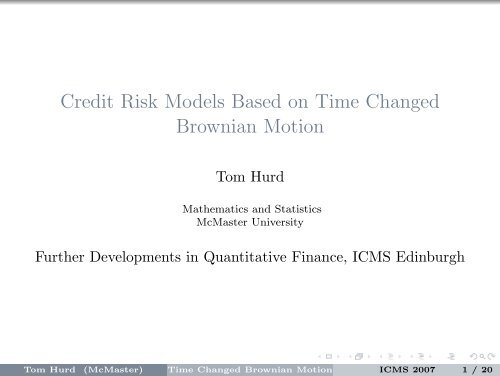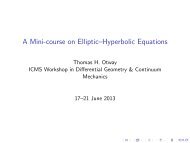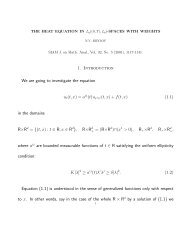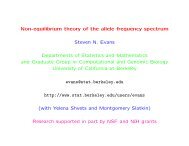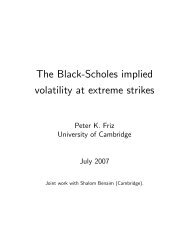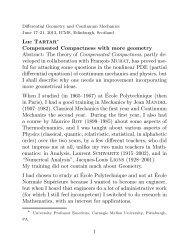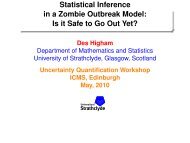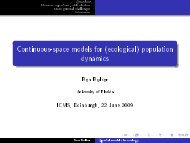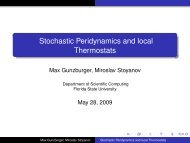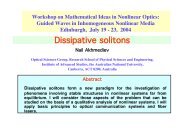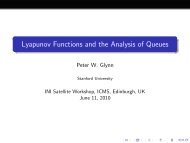Credit Risk Models Based on Time Changed Brownian Motion - ICMS
Credit Risk Models Based on Time Changed Brownian Motion - ICMS
Credit Risk Models Based on Time Changed Brownian Motion - ICMS
Create successful ePaper yourself
Turn your PDF publications into a flip-book with our unique Google optimized e-Paper software.
<str<strong>on</strong>g>Credit</str<strong>on</strong>g> <str<strong>on</strong>g>Risk</str<strong>on</strong>g> <str<strong>on</strong>g>Models</str<strong>on</strong>g> <str<strong>on</strong>g>Based</str<strong>on</strong>g> <strong>on</strong> <strong>Time</strong> <strong>Changed</strong><strong>Brownian</strong> Moti<strong>on</strong>Tom HurdMathematics and StatisticsMcMaster UniversityFurther Developments in Quantitative Finance, <strong>ICMS</strong> EdinburghTom Hurd (McMaster) <strong>Time</strong> <strong>Changed</strong> <strong>Brownian</strong> Moti<strong>on</strong> <strong>ICMS</strong> 2007 1 / 20
1 Overview2 Structural <str<strong>on</strong>g>Credit</str<strong>on</strong>g> Model: Black-Cox 19763 <strong>Time</strong> <strong>Changed</strong> <strong>Brownian</strong> Moti<strong>on</strong>4 First passage time for time-changed BM5 Multifirm Jump-Diffusi<strong>on</strong> Model6 Joint Equity-Default <str<strong>on</strong>g>Models</str<strong>on</strong>g>7 C<strong>on</strong>clusi<strong>on</strong>Tom Hurd (McMaster) <strong>Time</strong> <strong>Changed</strong> <strong>Brownian</strong> Moti<strong>on</strong> <strong>ICMS</strong> 2007 2 / 20
Tor<strong>on</strong>to: the place to be in 2010 !Where are you going to be in 2010 ?Tom Hurd (McMaster) <strong>Time</strong> <strong>Changed</strong> <strong>Brownian</strong> Moti<strong>on</strong> <strong>ICMS</strong> 2007 3 / 20
Tor<strong>on</strong>to: the place to be in 2010 !Where are you going to be in 2010 ?The Fields Institute is going to host a thematic program inMathematical FinanceTom Hurd (McMaster) <strong>Time</strong> <strong>Changed</strong> <strong>Brownian</strong> Moti<strong>on</strong> <strong>ICMS</strong> 2007 3 / 20
Tor<strong>on</strong>to: the place to be in 2010 !Where are you going to be in 2010 ?The Fields Institute is going to host a thematic program inMathematical FinanceActivities from January to July 2010 include: 3 major workshops,4-6 weekend meetings, 3 graduate courses.Tom Hurd (McMaster) <strong>Time</strong> <strong>Changed</strong> <strong>Brownian</strong> Moti<strong>on</strong> <strong>ICMS</strong> 2007 3 / 20
Tor<strong>on</strong>to: the place to be in 2010 !Where are you going to be in 2010 ?The Fields Institute is going to host a thematic program inMathematical FinanceActivities from January to July 2010 include: 3 major workshops,4-6 weekend meetings, 3 graduate courses.Main themes are: mathematical foundati<strong>on</strong>s, computati<strong>on</strong>alfinance, and emerging applicati<strong>on</strong>s .Tom Hurd (McMaster) <strong>Time</strong> <strong>Changed</strong> <strong>Brownian</strong> Moti<strong>on</strong> <strong>ICMS</strong> 2007 3 / 20
Tor<strong>on</strong>to: the place to be in 2010 !Where are you going to be in 2010 ?The Fields Institute is going to host a thematic program inMathematical FinanceActivities from January to July 2010 include: 3 major workshops,4-6 weekend meetings, 3 graduate courses.Main themes are: mathematical foundati<strong>on</strong>s, computati<strong>on</strong>alfinance, and emerging applicati<strong>on</strong>s .Opportunities for l<strong>on</strong>g and short term visitors, postdocs, graduatestudents, etc.Tom Hurd (McMaster) <strong>Time</strong> <strong>Changed</strong> <strong>Brownian</strong> Moti<strong>on</strong> <strong>ICMS</strong> 2007 3 / 20
Tor<strong>on</strong>to: the place to be in 2010 !Where are you going to be in 2010 ?The Fields Institute is going to host a thematic program inMathematical FinanceActivities from January to July 2010 include: 3 major workshops,4-6 weekend meetings, 3 graduate courses.Main themes are: mathematical foundati<strong>on</strong>s, computati<strong>on</strong>alfinance, and emerging applicati<strong>on</strong>s .Opportunities for l<strong>on</strong>g and short term visitors, postdocs, graduatestudents, etc.C<strong>on</strong>tact the organizers: TRH and Matheus Grasselli (McMaster),M. Rindesbacher (U of T), V. Henders<strong>on</strong> (Warwick), Y.Ait-Sahalia (Princet<strong>on</strong>).Tom Hurd (McMaster) <strong>Time</strong> <strong>Changed</strong> <strong>Brownian</strong> Moti<strong>on</strong> <strong>ICMS</strong> 2007 3 / 20
Two outstanding issues in credit risk1 For <strong>on</strong>e firm, how can <strong>on</strong>e flexibly model default dynamics (b<strong>on</strong>dsand other debt securities) jointly with equity dynamics (stocks andequity opti<strong>on</strong>s), c<strong>on</strong>sistent with arbitrage pricing theory?Tom Hurd (McMaster) <strong>Time</strong> <strong>Changed</strong> <strong>Brownian</strong> Moti<strong>on</strong> <strong>ICMS</strong> 2007 4 / 20
Two outstanding issues in credit risk1 For <strong>on</strong>e firm, how can <strong>on</strong>e flexibly model default dynamics (b<strong>on</strong>dsand other debt securities) jointly with equity dynamics (stocks andequity opti<strong>on</strong>s), c<strong>on</strong>sistent with arbitrage pricing theory?2 How can <strong>on</strong>e put these <strong>on</strong>e firm models together efficiently to pricelarge scale portfolio credit products like “Collateralized DebtObligati<strong>on</strong>s”?Tom Hurd (McMaster) <strong>Time</strong> <strong>Changed</strong> <strong>Brownian</strong> Moti<strong>on</strong> <strong>ICMS</strong> 2007 4 / 20
Black-Cox (1976)A time-c<strong>on</strong>sistent modificati<strong>on</strong> of Mert<strong>on</strong>’s 1974 model:1 Value of a firm: Vt = exp[log V 0 + σW t + (µ − 1 2 σ2 )t]2 Moving debt barrier: K(t) = exp[log K0 + γt];3 Log-leverage ratio:L t = 1 σ log(V t/K(t)) = L 0 + W t + (µ − 1 2 σ2 − γ)t;4 Default occurs at first time Lt ≤ 0;5 First passage time:t ∗ = t ∗ a,b := inf{t|W t + a − bt ≤ 0}where a = L 0 and b = 1 σ ( 1 2 σ2 + γ − µ).6 This leads to the famous formula:( ) ( )−a + bt−a − btP [t ∗ a,b ≤ t] = F (a, b, t) := Φ √ + e −2ba Φ √t tTom Hurd (McMaster) <strong>Time</strong> <strong>Changed</strong> <strong>Brownian</strong> Moti<strong>on</strong> <strong>ICMS</strong> 2007 5 / 20
Difficulties with Black-Cox1 Defaults are predictable, which implies incorrect short timebehaviour;2 The extensi<strong>on</strong> to M firms is very difficult: the distributi<strong>on</strong> of firstpassage times for correlated <strong>Brownian</strong> Moti<strong>on</strong>s is basically anunsolvable problem! Zhou (2001) solves it for M = 2, but higherM seems unreachable.3 Rigid structure is hard to fit to real data.Is there another way?Tom Hurd (McMaster) <strong>Time</strong> <strong>Changed</strong> <strong>Brownian</strong> Moti<strong>on</strong> <strong>ICMS</strong> 2007 6 / 20
Other Approaches1 Reduced form models beginning with Jarrow-Turnbull (1995) haveunpredictable defaults with an exogeneously given instantaneoushazard rate;2 Jarrow-Lando-Turnbull 1997 model the credit rating as a Markovchain with stochastic transiti<strong>on</strong> probabilities. This modelinterpolates between structural and reduced form frameworks.3 Lando (1998), Arvanitis-Gregory-Laurent (1999), Hurd-Kuznetsov(2007) give computati<strong>on</strong>ally efficient versi<strong>on</strong>s of JLT.4 Carr-Wu (2005) give reduced form models with the hazard ratetied to the level of the stock price.Tom Hurd (McMaster) <strong>Time</strong> <strong>Changed</strong> <strong>Brownian</strong> Moti<strong>on</strong> <strong>ICMS</strong> 2007 7 / 20
Jump-Diffusi<strong>on</strong> Stock <str<strong>on</strong>g>Models</str<strong>on</strong>g>Many famous stock models can be written in terms of time-changeddrifting <strong>Brownian</strong> Moti<strong>on</strong>.1 Log stock process log St := s t = s 0 + [W Gt + βG t ] for someincreasing process G t independent of W .2 For example, the Variance Gamma model of Madan et al takes Gtas a Gamma process with two parameters.3 Other Lévy models: NIG, Meixner, hyperbolic, etc.4 Stochastic volatility models: Gt = ∫ t0 λ sds, λ t ∼ CIR.5 In cases of interest, the characteristic functi<strong>on</strong> ΦG (u, t) = E[e iuGt ]is explicit.6 Further flexibility: if G = G (1) + G (2) where G (1) , G (2) areindependent, thenΦ G (u, t) = Φ G (1)(u, t)Φ G (2)(u, t)Tom Hurd (McMaster) <strong>Time</strong> <strong>Changed</strong> <strong>Brownian</strong> Moti<strong>on</strong> <strong>ICMS</strong> 2007 8 / 20
Jump-Diffusi<strong>on</strong> Default <str<strong>on</strong>g>Models</str<strong>on</strong>g>1 Rather than the stock price, instead focus <strong>on</strong> the log-leverage ratio( )VtL t = logK(t)2 Write it as the time-change of arithmetic drifting <strong>Brownian</strong>Moti<strong>on</strong>:L t = X Gt , X t = x + W t + βtTom Hurd (McMaster) <strong>Time</strong> <strong>Changed</strong> <strong>Brownian</strong> Moti<strong>on</strong> <strong>ICMS</strong> 2007 9 / 20
A sample path of Lévy time change G t43.532.521.510.500 0.5 1 1.5 2 2.5 3 3.5 4Tom Hurd (McMaster) <strong>Time</strong> <strong>Changed</strong> <strong>Brownian</strong> Moti<strong>on</strong> <strong>ICMS</strong> 2007 10 / 20
First passage times for time-changed BM1 The usual extensi<strong>on</strong> of the Black-Cox model would be to definedefault time to be the first passage time:t (1) = inf{t|L t ≤ 0}2 This has been well studied, and is difficult to compute!3 Here is an alternative:t (2) = inf{t|G t ≥ t ∗ }wheret ∗ = inf{t|X t ≤ 0}4 This is relatively easy to compute.5 The natural stopped process is L(2)t := X Gt∧t ∗.Tom Hurd (McMaster) <strong>Time</strong> <strong>Changed</strong> <strong>Brownian</strong> Moti<strong>on</strong> <strong>ICMS</strong> 2007 11 / 20
B<strong>on</strong>d Pricing Formulas1 Default probability before time t:P (t, x) = P [t (2) ≤ t] = E[P [t ∗ ≤ y|G t = y]]=∫ ∞0= 12πF (x, β, y)ρ t (y)dy∫ ∞−iɛ−∞−iɛe −x[β+√ β 2 +2iu]iuΦ G (u, t)duwhere ρ t is the PDF of G t . ɛ ∈ (0, ¯ɛ) is a regularizati<strong>on</strong> parameter.2 Price of zero coup<strong>on</strong> b<strong>on</strong>d with maturity T and fracti<strong>on</strong>al recoveryR:¯B RT (T ) = e −rT [R + (1 − R)P (T, x)]3 One can also price b<strong>on</strong>d opti<strong>on</strong>s in close-to-closed form.Tom Hurd (McMaster) <strong>Time</strong> <strong>Changed</strong> <strong>Brownian</strong> Moti<strong>on</strong> <strong>ICMS</strong> 2007 12 / 20
Example1 Take L0 = 1;2 Take b = 0.09, so the stock volatility is approximately 30%;3 Take G to have Lévy distributi<strong>on</strong> ν(y) = cae −ay with jumpintensity c = 0.01 and mean jump size a −1 .Then the hazard rate for default (the instantaneous default rate) is( ) −a V0h 0 = cD(0)Tom Hurd (McMaster) <strong>Time</strong> <strong>Changed</strong> <strong>Brownian</strong> Moti<strong>on</strong> <strong>ICMS</strong> 2007 13 / 20
Numerics706030 Year Yield Spread CurvesNo JumpsMean jump size 0.3Mean jump size 1.0Mean jump size 3.0Yield Spread (in BPS)504030201000 5 10 15 20 25 30MaturityFigure: Thirty year yield spreads in basis points, c = 0.01 anda −1 = 0.30, 1.0, 3.0.Tom Hurd (McMaster) <strong>Time</strong> <strong>Changed</strong> <strong>Brownian</strong> Moti<strong>on</strong> <strong>ICMS</strong> 2007 14 / 20
NumericsYield Spread0.35$L 0=0.3$0.3$L 0=0.6$0.25 $L =1.0$ 00.2 $L 0=2.0$0.150.130 Year Yield Spread Curves0.0500 5 10 15 20 25 30MaturityFigure: Thirty year yield spreads with four different valuesL 0 = 0.3, 0.6, 1.0, 2.0.Tom Hurd (McMaster) <strong>Time</strong> <strong>Changed</strong> <strong>Brownian</strong> Moti<strong>on</strong> <strong>ICMS</strong> 2007 15 / 20
A Simple Multifirm Model1 Take independent drifting BMs {X 1 , X 2 , . . . , X M }, andparameters {x i , β i }2 Subject them to the same time-change Gt :L i (t) = X i G t3 Moments:Mean = E[L i t] = x i + β i tE[G 1 ]/2Variance = Var[L i t] = t(E[G 1 ] + (β i ) 2 Var[G 1 ])Correlati<strong>on</strong> ρ ij =(1 + E[G(1)] ) () −1/2 −1/2βi 2Var[G(1)] 1 + E[G(1)]βj 2Var[G(1)] Tom Hurd (McMaster) <strong>Time</strong> <strong>Changed</strong> <strong>Brownian</strong> Moti<strong>on</strong> <strong>ICMS</strong> 2007 16 / 20
Computing the Joint Default Distributi<strong>on</strong>1 P (Σ, t), the probability that the default subset is Σ ⊂ {1, . . . , M},is:P (Σ, t) =∫ ∞2 Finally, P [Nt ≥ k] is given by0[ ] [ ∏ ∏F (x i , β i , g) (1 − F (x i , β i , g))i∈Σi/∈Σ∑Σ:|Σ|≥kP (Σ, t)]ρ t (g)dg3 Main C<strong>on</strong>clusi<strong>on</strong>: Subjecting M independent <strong>Brownian</strong> Moti<strong>on</strong>s toan identical time-change process leads to <strong>on</strong>e-dimensi<strong>on</strong>al integral!Tom Hurd (McMaster) <strong>Time</strong> <strong>Changed</strong> <strong>Brownian</strong> Moti<strong>on</strong> <strong>ICMS</strong> 2007 17 / 20
Joint Equity-Default <str<strong>on</strong>g>Models</str<strong>on</strong>g>Here is a simple “<strong>on</strong>e–factor” model that extends stock price modelslike the VG and NIG models to include default:1 Debt per share at time t: D(t) = e rt D 0 ;2 Pre-default share price (equity per share) at time tS t + D(t) = D(t)e Lt3 Jump-diffusi<strong>on</strong> dynamics with Xt = x + W t + βt and time changeG:L t = log(V t /D(t)) = X Gt4 Default is the first time Gt exceeds t ∗ , which is also the first timeS(t) = 0.5 Healthy firm: St ≫ D(t), so S t ∼ D(t)e Lt is approximately theusual “geometric” dynamics.6 Unhealthy firm: St D(t), dynamics is “arithmetic”.Tom Hurd (McMaster) <strong>Time</strong> <strong>Changed</strong> <strong>Brownian</strong> Moti<strong>on</strong> <strong>ICMS</strong> 2007 18 / 20
<str<strong>on</strong>g>Risk</str<strong>on</strong>g> Neutral DynamicsSuppose W t is a BM. Note1 eX tis a σ(W )-martingale if X t = x + W t − t/2;Tom Hurd (McMaster) <strong>Time</strong> <strong>Changed</strong> <strong>Brownian</strong> Moti<strong>on</strong> <strong>ICMS</strong> 2007 19 / 20
<str<strong>on</strong>g>Risk</str<strong>on</strong>g> Neutral DynamicsSuppose W t is a BM. Note1 eX tis a σ(W )-martingale if X t = x + W t − t/2;2 eX t∧t∗ is a σ(W )-martingale for any σ(W )-stopping time t ∗ (byOpti<strong>on</strong>al Sampling);Tom Hurd (McMaster) <strong>Time</strong> <strong>Changed</strong> <strong>Brownian</strong> Moti<strong>on</strong> <strong>ICMS</strong> 2007 19 / 20
<str<strong>on</strong>g>Risk</str<strong>on</strong>g> Neutral DynamicsSuppose W t is a BM. Note1 eX tis a σ(W )-martingale if X t = x + W t − t/2;2 eX t∧t∗ is a σ(W )-martingale for any σ(W )-stopping time t ∗ (byOpti<strong>on</strong>al Sampling);3 eL (2)t is a F t -martingale, where L (2)t := X Gt∧t ∗ is the time-changedstopped martingale.Tom Hurd (McMaster) <strong>Time</strong> <strong>Changed</strong> <strong>Brownian</strong> Moti<strong>on</strong> <strong>ICMS</strong> 2007 19 / 20
<str<strong>on</strong>g>Risk</str<strong>on</strong>g> Neutral DynamicsSuppose W t is a BM. Note1 eX tis a σ(W )-martingale if X t = x + W t − t/2;2 eX t∧t∗ is a σ(W )-martingale for any σ(W )-stopping time t ∗ (byOpti<strong>on</strong>al Sampling);3 eL (2)t is a F t -martingale, where L (2)t := X Gt∧t ∗ is the time-changedstopped martingale.4 Therefore e −rt S t = D 0 (e L(2) t− 1) is a F t -martingale;Tom Hurd (McMaster) <strong>Time</strong> <strong>Changed</strong> <strong>Brownian</strong> Moti<strong>on</strong> <strong>ICMS</strong> 2007 19 / 20
<str<strong>on</strong>g>Risk</str<strong>on</strong>g> Neutral DynamicsSuppose W t is a BM. Note1 eX tis a σ(W )-martingale if X t = x + W t − t/2;2 eX t∧t∗ is a σ(W )-martingale for any σ(W )-stopping time t ∗ (byOpti<strong>on</strong>al Sampling);3 eL (2)t is a F t -martingale, where L (2)t := X Gt∧t ∗ is the time-changedstopped martingale.4 Therefore e −rt S t = D 0 (e L(2) t5 The model is arbitrage-free!− 1) is a F t -martingale;Tom Hurd (McMaster) <strong>Time</strong> <strong>Changed</strong> <strong>Brownian</strong> Moti<strong>on</strong> <strong>ICMS</strong> 2007 19 / 20
<str<strong>on</strong>g>Risk</str<strong>on</strong>g> Neutral DynamicsSuppose W t is a BM. Note1 eX tis a σ(W )-martingale if X t = x + W t − t/2;2 eX t∧t∗ is a σ(W )-martingale for any σ(W )-stopping time t ∗ (byOpti<strong>on</strong>al Sampling);3 eL (2)t is a F t -martingale, where L (2)t := X Gt∧t ∗ is the time-changedstopped martingale.4 Therefore e −rt S t = D 0 (e L(2) t5 The model is arbitrage-free!− 1) is a F t -martingale;6 St first hits zero at precisely t (2) , and remains zero thereafter.Tom Hurd (McMaster) <strong>Time</strong> <strong>Changed</strong> <strong>Brownian</strong> Moti<strong>on</strong> <strong>ICMS</strong> 2007 19 / 20
Equity-<str<strong>on</strong>g>Credit</str<strong>on</strong>g> Computati<strong>on</strong>sfor any α ∈ (1, α max ).Tom Hurd (McMaster) <strong>Time</strong> <strong>Changed</strong> <strong>Brownian</strong> Moti<strong>on</strong> <strong>ICMS</strong> 2007 20 / 20Pricing credit derivatives is identical to before. Equity derivatives arealso (almost) explicit:Propositi<strong>on</strong>A call opti<strong>on</strong> <strong>on</strong> the stock with maturity T and strike KC(S 0 , T, K) = E Q [e −rT (S T − K) + 1 {t (2) >T } ]has price C(S 0 , T, K) = D 0 f(T, log(1 − S 0 /D 0 ), log(1 + e −rT K/D 0 )),where <strong>on</strong>e has a c<strong>on</strong>vergent Fourier integralf(T, x, k) = E x [E[(e L T− e k ) + |G T ]][× N∫ ∞e iuk−k(α−1)= 12π −∞( ) x + (β + iu)t√ − e −2(β+iu)x Nt(α − 1 − iu)(α − iu) eiu(x+βt)−u2 t/2( −x + (β + iu)t√t)]du
C<strong>on</strong>clusi<strong>on</strong>1 By taking Lt = X Gt with different time changes G t , <strong>on</strong>e has a richvariety of generalized Black-Cox models;Tom Hurd (McMaster) <strong>Time</strong> <strong>Changed</strong> <strong>Brownian</strong> Moti<strong>on</strong> <strong>ICMS</strong> 2007 21 / 20
C<strong>on</strong>clusi<strong>on</strong>1 By taking Lt = X Gt with different time changes G t , <strong>on</strong>e has a richvariety of generalized Black-Cox models;2 With the simple idea of shared time-change, an interesting andcomputable “<strong>on</strong>e-factor” multifirm correlati<strong>on</strong> structure emerges.Tom Hurd (McMaster) <strong>Time</strong> <strong>Changed</strong> <strong>Brownian</strong> Moti<strong>on</strong> <strong>ICMS</strong> 2007 21 / 20
C<strong>on</strong>clusi<strong>on</strong>1 By taking Lt = X Gt with different time changes G t , <strong>on</strong>e has a richvariety of generalized Black-Cox models;2 With the simple idea of shared time-change, an interesting andcomputable “<strong>on</strong>e-factor” multifirm correlati<strong>on</strong> structure emerges.3 The extensi<strong>on</strong> to include equity is compatible with well-studiedstock price models like the VG, NIG and stochastic volatilitymodels;Tom Hurd (McMaster) <strong>Time</strong> <strong>Changed</strong> <strong>Brownian</strong> Moti<strong>on</strong> <strong>ICMS</strong> 2007 21 / 20
C<strong>on</strong>clusi<strong>on</strong>1 By taking Lt = X Gt with different time changes G t , <strong>on</strong>e has a richvariety of generalized Black-Cox models;2 With the simple idea of shared time-change, an interesting andcomputable “<strong>on</strong>e-factor” multifirm correlati<strong>on</strong> structure emerges.3 The extensi<strong>on</strong> to include equity is compatible with well-studiedstock price models like the VG, NIG and stochastic volatilitymodels;4 With t (2) , the martingale c<strong>on</strong>diti<strong>on</strong> for S t is explicitly verifiable;Tom Hurd (McMaster) <strong>Time</strong> <strong>Changed</strong> <strong>Brownian</strong> Moti<strong>on</strong> <strong>ICMS</strong> 2007 21 / 20
C<strong>on</strong>clusi<strong>on</strong>1 By taking Lt = X Gt with different time changes G t , <strong>on</strong>e has a richvariety of generalized Black-Cox models;2 With the simple idea of shared time-change, an interesting andcomputable “<strong>on</strong>e-factor” multifirm correlati<strong>on</strong> structure emerges.3 The extensi<strong>on</strong> to include equity is compatible with well-studiedstock price models like the VG, NIG and stochastic volatilitymodels;4 With t (2) , the martingale c<strong>on</strong>diti<strong>on</strong> for S t is explicitly verifiable;5 Our joint equity-credit model takes into account the influence ofstock value <strong>on</strong> default hazard rates.Tom Hurd (McMaster) <strong>Time</strong> <strong>Changed</strong> <strong>Brownian</strong> Moti<strong>on</strong> <strong>ICMS</strong> 2007 21 / 20
C<strong>on</strong>clusi<strong>on</strong>1 By taking Lt = X Gt with different time changes G t , <strong>on</strong>e has a richvariety of generalized Black-Cox models;2 With the simple idea of shared time-change, an interesting andcomputable “<strong>on</strong>e-factor” multifirm correlati<strong>on</strong> structure emerges.3 The extensi<strong>on</strong> to include equity is compatible with well-studiedstock price models like the VG, NIG and stochastic volatilitymodels;4 With t (2) , the martingale c<strong>on</strong>diti<strong>on</strong> for S t is explicitly verifiable;5 Our joint equity-credit model takes into account the influence ofstock value <strong>on</strong> default hazard rates.6 Computati<strong>on</strong>s are based intensively <strong>on</strong> Fast Fourier Transform;Tom Hurd (McMaster) <strong>Time</strong> <strong>Changed</strong> <strong>Brownian</strong> Moti<strong>on</strong> <strong>ICMS</strong> 2007 21 / 20
C<strong>on</strong>clusi<strong>on</strong>1 By taking Lt = X Gt with different time changes G t , <strong>on</strong>e has a richvariety of generalized Black-Cox models;2 With the simple idea of shared time-change, an interesting andcomputable “<strong>on</strong>e-factor” multifirm correlati<strong>on</strong> structure emerges.3 The extensi<strong>on</strong> to include equity is compatible with well-studiedstock price models like the VG, NIG and stochastic volatilitymodels;4 With t (2) , the martingale c<strong>on</strong>diti<strong>on</strong> for S t is explicitly verifiable;5 Our joint equity-credit model takes into account the influence ofstock value <strong>on</strong> default hazard rates.6 Computati<strong>on</strong>s are based intensively <strong>on</strong> Fast Fourier Transform;7 Once the FFT is safely working and a good opti<strong>on</strong>/CDS data setis obtained, risk-neutral calibrati<strong>on</strong> should be straightforward.Tom Hurd (McMaster) <strong>Time</strong> <strong>Changed</strong> <strong>Brownian</strong> Moti<strong>on</strong> <strong>ICMS</strong> 2007 21 / 20


